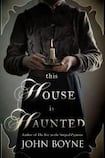
John Boyne is one of Ireland's most popular writers. The author of 10 novels, translated into 45 languages, he shot to international fame with The Boy in the Striped Pyjamas , which won several prizes and became a successful film.
Like many of his books, The Boy in the Striped Pyjamas is a historical novel. This House Is Haunted may fall into this category, although it is not easy to categorise. Is it for adults or for young people? Is it a parody or a straightforward ghost story? Or simply a work written in homage to Charles Dickens?
The novel is narrated by Eliza Caine, a young schoolteacher and staunch admirer of Dickens. Set in 1867, it opens with a public reading by the great writer, attended by Eliza and her beloved father. Dickens reads a ghost story that terrifies some sensitive members of the audience – a harbinger of what is to come in Boyne’s novel.
On the way home from the reading, Eliza’s father catches cold and speedily dies. Deprived of her beloved parent, and of her house, she becomes a typical Dickensian orphan. She resigns from her school, somewhat abruptly, and less than a week after the death of her father finds herself in Gaudlin Hall as governess to two weird children.
Even as she arrives at the local railway station, the reader, forewarned by the title and the suitably eerie cover, realises there are difficult times ahead. An invisible hand tries to shove Eliza under a train, the first of many assaults she receives from the pushy ghost of Gaudlin Hall. On the platform she meets a helpful Dr Toxley, who is friendly until Gaudlin is named. Then he falls into “an uncomfortable silence”, the standard reaction of all the villagers to any mention of the place. However, Eliza doesn’t take the hint (or the London train) but steps into the waiting carriage and is driven, by a rough farmhand, to her fate.
So this is a ripping yarn, very readable and highly entertaining, even if you have difficulty in suspending disbelief, and even more in understanding why any 21st-century writer would choose to write an imitation of a 19th-century novel. It is probably in homage to Dickens, as frequent references to his works and the inclusion of Dickensian hallmarks – such as the use of the names Mr Raisin, Mr Cratchett and Eliza Caine, and the proponderance of orphans – attest.
There are nods to other writers too: Eliza is a Brontëan heroine, an unattractive girl who must work for her living. There are a sick spouse hidden away in an attic and a madwoman, who, like many such in English fiction, is a foreigner from a spooky Catholic country. (Spain, in this instance.) A Baskerville-type hound makes a brief appearance.
The strongest influence, however, the literary ghost hidden in the book's own attic, is probably Henry James's The Turn of the Screw .
Characterisation is one of the novel's great strengths. All the characters are well drawn, and Eliza is a compelling protagonist, reminiscent of Esther Summerson in Bleak House : sympathetic, brave and intelligent, at least up to the point where average cop-on would threaten the plot.
She is also interestingly ahead of her time. While Boyne is convincing in evoking period atmosphere, he allows himself some liberty where issues such as gender equality are concerned. Eliza questions the conventional role of women much more often than a real mid-19th-century heroine would, but he handles this aspect of her character well, and humorously.
There are reflections on euthanasia, child abuse and prisons, which seem anachronistic but are deftly adapted to the historical context. Even the language succeeds, impressively, in sounding sort of Dickensian (or Wilkie Collinsian), although expressions from a later stage of English creep in now and then – “She’s very damaged,” for example. But these infelicities are rare and not jarring.
In its closing chapters the novel swerves from the relatively restrained melodramatic conventions of 19th-century gothic to the graphic violence of today's horror fiction and film. For me this is a step too far. It confirms the novel's reliance not just on ghost belief but also on belief in ghosts that behave like violent psychopaths, out of their minds on drugs. (In folklore, the "dead without status", the kind of ghosts with which this book is concerned, tend to have limited powers. They are predictable and rather boring.) Unlike, for example, The Turn of the Screw , This House Is Haunted does not allow a psychological explanation of its intrigue. Nor is it a parody of the gothic genre, like Jane Austen's Northanger Abbey . It is, and no doubt was intended to be, a straighforward ghost story, written in a competent reconstruction of the style of 19th-century English novels. And, for young readers, it will be more accessible than the real thing. And this may be the point.
I found it a bit silly but thoroughly enjoyable, at least until the slash-and-burn Ragnarök of the final sequence. Endings are never easy, however, especially in this genre. I read the novel compulsively on a long train journey, for which it was, as Eliza Caine might put it, a most agreeable companion. It’s also very visual, and unfolds like a film. Lots of the locations are familar: we have seen the railway station, the crumbling hall, the stables and the London fog hundreds of times on the little screen and the big screen. This novel would work very well on either.
Éilís Ní Dhuibhne teaches creative writing at University College Dublin. Her most recent books are
Dordán
and
The Shelter of Neighbours













